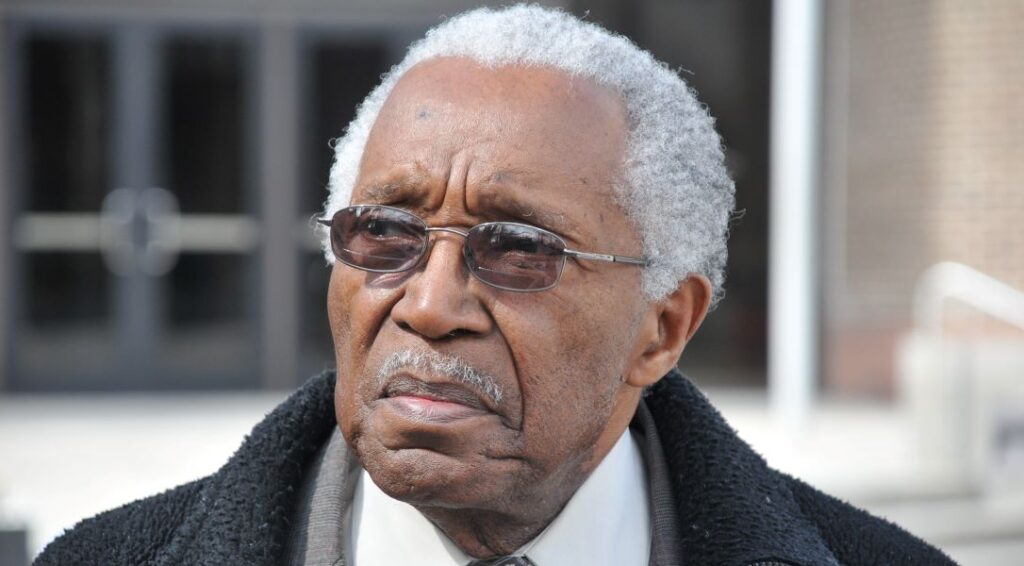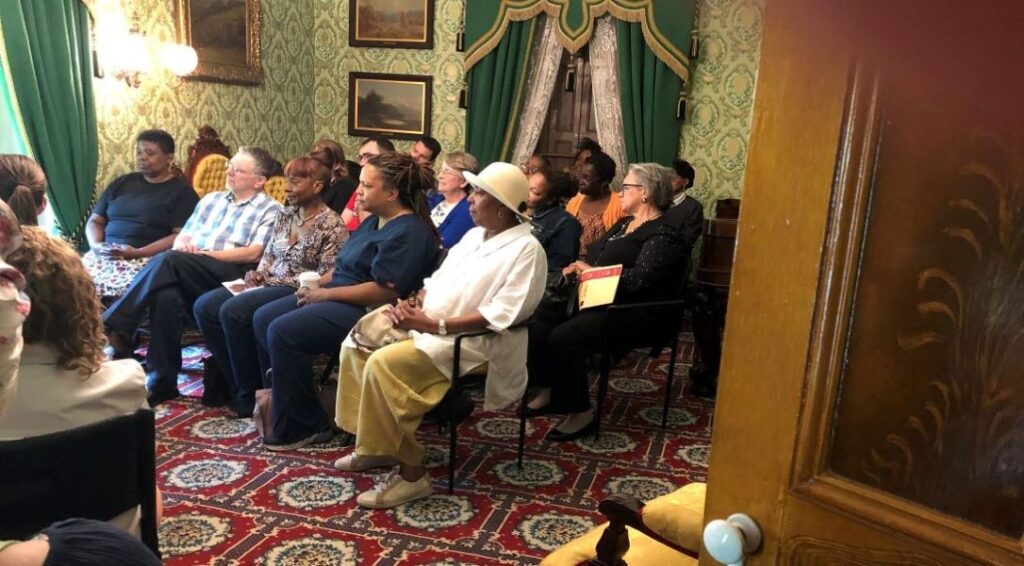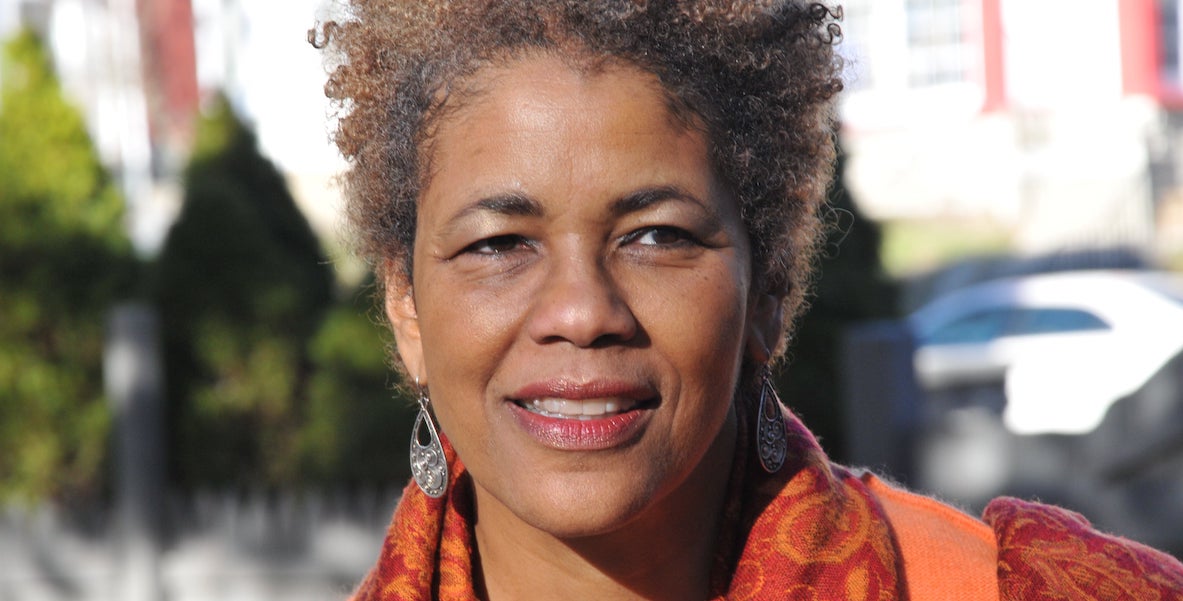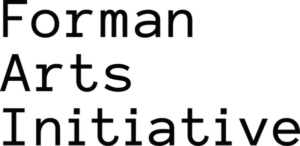The wisdom of African American elders has always been a driving force for Germantown-based oral historian Julie Rainbow. As a young girl in Raleigh, North Carolina, Rainbow grew up listening to, and embodying, the stories passed down from her older relatives, stories she learned to recognize as the bricks of her community.
Today, Rainbow is what she calls an “Elder Scribe,” whose oral history project, Journey to Sanctuary, tells the stories of African Americans who moved to Germantown from points South between 1940 and 1970—the Second Great Migration of Black Americans to the north. But to Rainbow, again, these stories are more than just personal tales of bravery and resilience. They are what comprise a community—individuals coming together to form a whole.
“As an Elder Scribe [I ask myself], how do you tell the stories of the aging population in such a way that they connect to all other generations? What is their story and how does it connect to history?” Rainbow says. “[These oral histories will create] a community archive and collective memory of this period of time.”
In partnership with the Forman Arts Initiative, The Citizen reached out to Rainbow to find out more about her work, and its resonance for today. This interview has been edited and condensed.
![]()
Blake Bradford: You’re from North Carolina, but are now living in Philadelphia. Where do you consider home?
Julie Rainbow: I live on the borderline of Germantown and Mt. Airy, but I consider myself in Germantown. This is my second time in the area. Originally, after working at Mellon Bank in Center City, I was here to go to Bryn Mawr’s Graduate School of Social Work and Social Research. I came back to Philly in 2013.
There was something about the city that really resonated with me. I decided to focus on the stories of elders, those individuals that have been able to turn their life experiences into wisdom.

I have been collecting oral histories of African American elders probably all my life, given the community that I grew up in Raleigh, North Carolina. In 2010, Philadelphia had the second largest population of people over 65 years of age. The resonance of the arts in Philadelphia, the presence of elders, and the aging population brought me back to the city.
BB: You mentioned community. Is that a Philadelphia neighborhood? Is it a community of practice? What is community to you?
JR: There isn’t one definition of community for me. Some of it is geographical, but it’s also common interest. My co-facilitator of the class at Drexel, the archivist Alex Poole, is definitely a part of my community. I need community wherever I go. I want to be in a place where I feel safe and secure, and part of that is connecting with my neighbors. Wherever I am geographically, I like to help the elders in that particular community to tell their story, which could expand the narrative of American history. We have living historians in Philadelphia whose stories have not been told. The tendency is to highlight individuals rather than communities. I like to really look at community rather than individuals.
Germantown is a contained community that is very, very unique. For my current project, Journey to Sanctuary, I am working with Historic Germantown and the Germantown Historical Society to tell the stories of African Americans who moved to this part of the city when they came from the South between 1940 and 1970. [These oral histories will create] a community archive and collective memory of this period of time.
BB: What role does culture play within the communities you’ve outlined?
JR: The word that comes to mind is “belonging.” For me, culture is bringing in different aspects of oneself and one’s community in such a way that, whether it’s an artist, an environmentalist or a caterer, people feel like they belong. How do we create this place where people feel safe and secure so they can express themselves in their full capacity, despite all the differences that exist? People think, theoretically, “Oh, that’s easy,” but how do you put this belonging into practice?
BB: What is the role of creativity for you and how is that part of your work as an Elder Scribe?
JR: Creativity is woven into everything that I do. It makes me ask: how do we present an idea in such a way that people feel like they belong? I’m always thinking of ways to create belonging amongst individuals, wherever I go.
Philadelphia is an old city. When I think of historic sites, I think of brick and mortar. That’s something that exists from generation to generation. Oftentimes, we rely on a period of time when these historic sites existed and we keep retelling that same history. We forget about the people who lived in the historic houses and the things that were important to them. How do we connect their stories to current-day issues?
One way I express my creativity is through oral history. I worked with Wyck House, where they have this massive collection of objects and artifacts that tell the stories of the families that lived in those houses. I conducted interviews with a swath of Germantown residents who identified an object that was important to them. They found something in the collection that was relatable. [Creativity is] thinking of ways to move out of the box, move out of the ordinary, to move away from the status quo, so that we can provide more relevance to the stories we tell.
How do you do that? Part of that is letting go of my prejudices. Going into a space, I become kind of neutral. People say you can’t be neutral, but I think you can be empty enough to allow things to emerge. That may sound kind of woo woo [laughs], but creativity is just being present and, for me, allowing ideas to come and acting on those ideas. It’s finding ways to engage the community. I think we have to move away from the more traditional ways. That’s where my creativity comes in, connecting with the people where you are.

BB: What could it mean to embrace creativity, in the manner you’ve described, on a citywide scale?
JR: When I came here to pursue my artistic and creative work, I wasn’t affiliated with a particular entity so that made it a little bit more challenging. People [in Philadelphia] kept saying to me, when I wanted them to think outside of the box, “That’s not how we do it here.” If I heard it once, I heard it a thousand times. I’ve gotten grants in Philadelphia, but there’s still a sense of “You’re not from here. Who are you affiliated with?” [They] won’t even hear me because I’m not a native of Philadelphia. I moved here from Atlanta. I read somewhere that 80 percent of the people in Atlanta are transplants. There’s a freshness, a newness; whereas 80 percent of the people in Philadelphia are from Philadelphia. There’s a sentiment of “This is the way we do it, this is the way we’ve done it, we don’t know you.”
I think it starts with individuals moving beyond their own ideology of whom they are going to value and looking at more expansive characteristics and virtues. How do you move from the theoretical “Yes, we want creative projects and we invite you to come,” to the practical? How do you create this openness among individuals and even institutions?
When I think of DEI—diversity, equity and inclusion—it’s still the sense that you have to get invited in [to these conversations], rather than creating a space where people belong and feel like they matter and have something to contribute. I don’t quite know the answers. I can only speak from my experiences as an outsider, an outsider who feels like I have something meaningful to offer and not necessarily having the opportunities to do so. I feel like, slowly but surely, I’m able to crack that mentality of not being open to outsiders. It’s been really difficult, but Philadelphia is a creative town.
Blake Bradford is a Philadelphia-based cultural advocate, educator and writer. His appointments include serving as the Director of the Lincoln University-Barnes Foundation Museum Studies Program and as the inaugural Bernard C. Watson Director of Education at the Barnes Foundation.
This story is part of a partnership between The Philadelphia Citizen and Forman Arts Initiative to highlight creatives in every neighborhood in Philadelphia. It will run on both The Citizen and FAI’s websites.
![]()
https://thephiladelphiacitizen.org/more-than-bbqs-and-mattress-sales/
Photo by Noah Rainbow Douglas




